14 Jun 2019 - {{hitsCtrl.values.hits}}
Presidential Election 2020: Only MS and RW are social media ready!
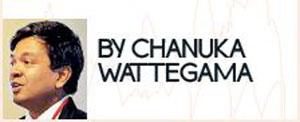
Social media have ascertained a dynamic and organic rapport with politics. Smartly hijacking the command print and broadcast media had over public affairs, now social media determine, to a large extent, how we are governed and by whom.
No doubt the political leaders, local and international, apprehend this clout. Still many are weak in exploiting that to their own political advantage. Social media blunders we have seen in recent India and Indonesia elections are not just limited to those two democracies.
An election-oriented social media strategy can be structured, semi structured or unstructured. In the first case, it is well organised and being run by paid professionals working in a centralised framework. The first well-known example is Barack Obama’s 2008 campaign, which turned the event to a ‘Facebook Election’.
One of Obama's key strategists was 24-year-old Chris Hughes, a Facebook cofounder, who masterminded everything from social media promotions to podcasting and mobile messaging. It also was the first US election in which all presidential candidates attempted linking with voters through online social networking platforms such as Facebook and MySpace. Then the practice became commonplace.
In the other extreme, we see campaigns being run almost entirely by unpaid but dedicated party followers who work on their own but contribute to a central promotion. This too can be a good guerrilla strategy, particularly when one is short of resources, though the risk of the same is higher.
A structured strategy, as we have seen multiple times, is not always superior to an unstructured one. A good local example could be the strategy, if it can be called such, of the ‘Common Opposition Candidate’ Maithripala Sirisena in 2015. Probably the lack of resources and time, didn’t allow a more structured operation.
So the social media battle against then incumbent President Mahinda Rajapaksa was effectively led by less than 50 extremely dedicated and smart activists working alone and had no direct and official links with either campaign. The government of course, had a more professional and structured social media strategy but it was the amateurs working assiduously ensured the critical marginal youth vote required to be elected.
Analysis and Indicators
This is an analysis of social media readiness or rather the lack of it – as you will see, of the 10 possible contenders of Presidential Election 2020. The same 10 contenders, on whom I focussed on earlier, were selected for this too. (‘Presidential Election 2020: Who has the Best Story?’ published in Daily Mirror Business, June 4, 2019) This assessment is based on the outcome, so whether it comes from a structured strategy or an unstructured one is immaterial.
Out of the indicators, six are quantitative and four qualitative. The former are more objective though there can be a slight increase (or decrease – not too likely) from the date of evaluation (June 6, 2019). All tests were conducted in a single day for a fair comparison.
One may argue the analysis should go beyond this rudimentary level for improved results. This is a valid argument. Far advanced tests exist for a better comparison. Still it was limited to this level, as you can observe from the results – the outcome shows more unpreparedness. A more advanced comparison would be appropriate few weeks before the election, not right now.
Benchmarks
The results were benchmarked against the standards based on the average performance of three selected non-political celebrities namely Kumar Sangakkara, Pooja Umashankar and Sanuka Wickramasinghe. (Except for Party Facebook page likes. See Table 1 for benchmarks) Satisfactory performances, according to these benchmarks, are highlighted in yellow. A still better performance is highlighted in green. The same standards are used for qualitative analysis too, though that can naturally be more subjective.
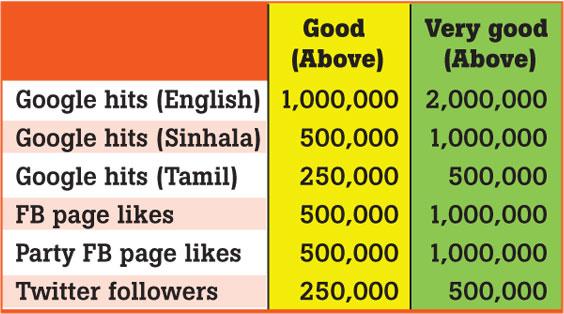
Contenders
Basil Rajapaksa:
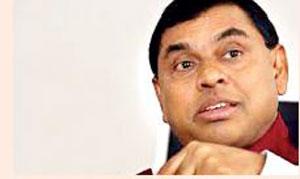
Arguably the most renowned election strategist on ground today, has paid little attention to social media. He seems to have three Twitter accounts; all look official, created at different points of his career but no tweets at all; could have also done better with the party and his own Facebook pages. It is good time for a party website too.
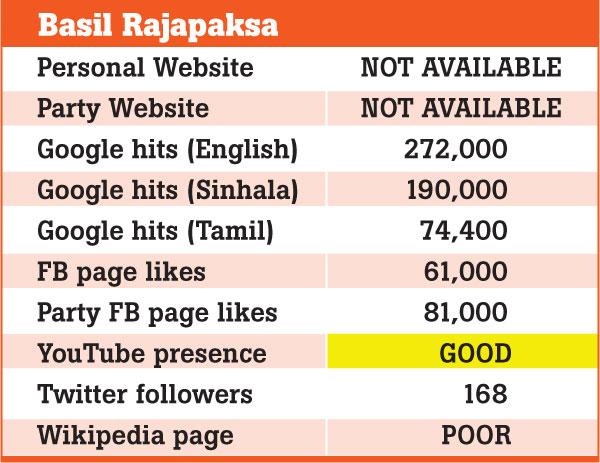
Chamal Rajapaksa:
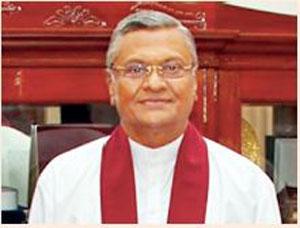
This former speaker cum former senior minister is not somebody whom you anticipate to meet often in virtual space. Perhaps he never attempted building a social media profile – his constituency is largely rural. If he ever plans to appear in a national level election, his team would need to burn too much midnight oil to get the work done.
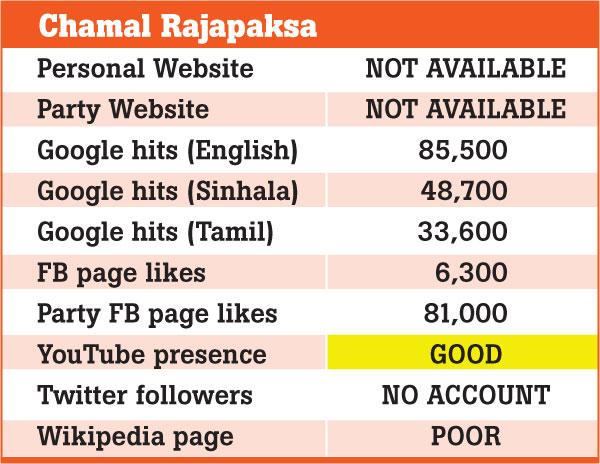
Dhammika Perera:

We can understand the still-non-committal-would-be-politician Dhammika Perera not having a good social media profile but elections or not, the successful business personality Dhammika Perera should pay more attention to building one for himself. Some of his speeches have received good response. For example, his recent one and half hour long speech ‘National Strategy using Artificial Intelligence’ has received more than 32,000 YouTube views. (This is obviously for the individual as a corporate video of his own company has not reached even 600 hits.) His previous speeches too are interesting. Perhaps Dhammika Perera has no idea that lecturers like myself use parts of them for teaching purposes. So, why not official YouTube and twitter accounts and more content like a set of brief speeches? Then to his LinkedIn account. The problem is not with audience. He has over 6,000 LinkedIn followers and some of his speeches are seen by nearly 20,000. Still this digital profile is not the one the country expects from a professional leader who promises to take us to the 21st century. (Said that my own LinkedIn profile too has not been updated for some time now, but I don’t plan to contest in any recent election.)
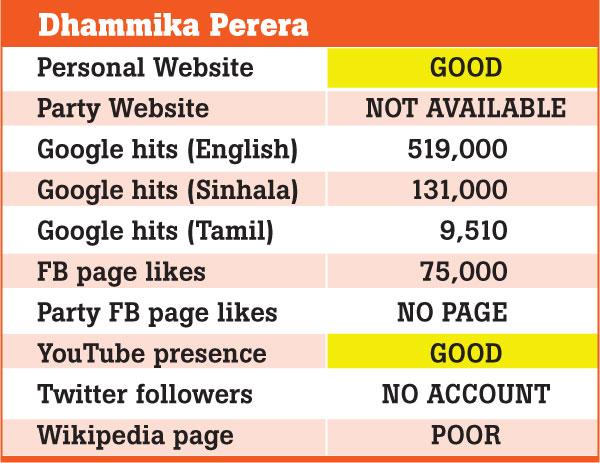
Gotabhaya Rajapaksa:
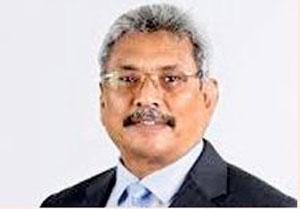
A true surprise. If one’s intentions to lead the country were to be based only on social media presence, no international political analyst would treat Gotabhaya Rajapaksa too seriously. What makes him visible – very visible – is the user generated content, not his own promotion material. The users create the best image presence on Facebook for him, perhaps even better in this case, than that of former President Mahinda Rajapaksa. The same trend can be seen in text and video content too. The problem: It is extremely risky to depend only on user content – no matter how large the volume – as there is little or no control. User content can be positive or negative. They also can change overnight with no warnings. Worse, the users can project their own views as his. It looks Rajapaksa is already encountering this problem. Few weeks back, his media spokesperson, Milinda Rajapaksa had to warn the content posted by those who take selfies with the former, need not necessarily officially endorsed. Certainly Gotabhaya Rajapaksa deserves a more focussed and professional social media campaign.
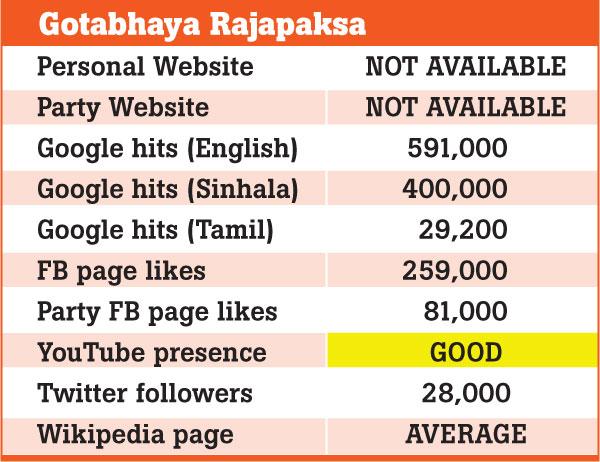
Karu Jayasuriya:

The Speaker tweets regularly and has more than 20,000 followers. Also two active Facebook pages, which look like operated by two teams. Both are definite pluses. But why not the Speaker, who symbolises the democracy and openness in the country, think a bit more about opening himself online? Surely it will pay in dividends. (A vital observation: He is the only one among all 10 who has more Google hits in Tamil than in Sinhala. Not sure this abnormality is due to a technical glitch.)

Maithripala Sirisena:
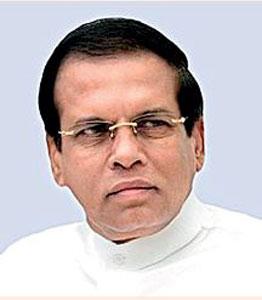
President Sirisena has near perfect social media presence. One must congratulate his social media teams for that professional work. His website is excellent. It provides all the necessary information a journo needs. Google hits for the name, naturally, are high in all three languages. His dynamic official Facebook page has a record 1,100,000 + likes. His Wikipedia page is comprehensive though it contains few inevitable negative remarks. Twitter and YouTube incidences too are great. If at all, something needs promotion, it’s the party.
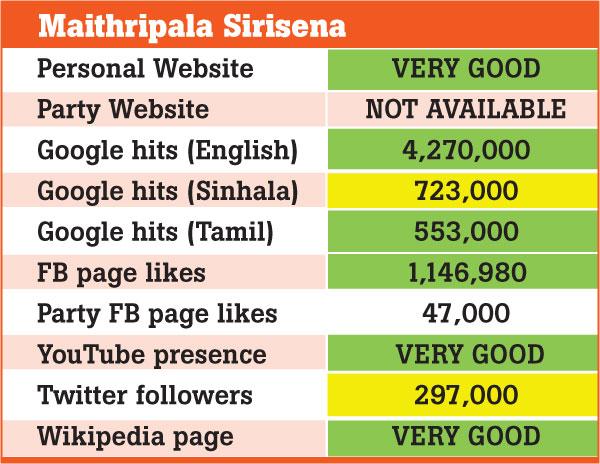
Nagananda Kodituwakku:
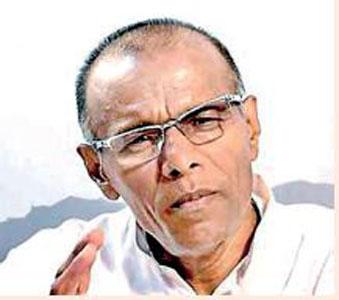
What can one say? Kodituwakku behaves as he is totally oblivious to social media. No Wikipedia page. No Twitter account. Not even a Facebook page. Only a mediocre website. Information Systems Management students learn this as Web 1.0 mind-set. Static Web 1.0 turned to more dynamic Web 2.0 somewhere around 2006-7 but it may take lot more years. This may be good evidence that not all have noted the transformation.
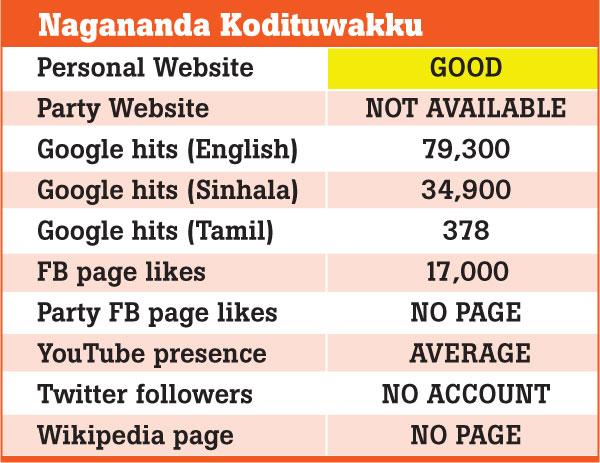
Ranil Wickremesinghe:
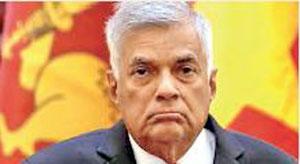
Prime Minister Ranil Wickremesinghe stands somewhere in between the very formal presence of President Sirisena and almost the user-generated presence of former Defence Secretary Gotabhaya Rajapaksa. His presence too seems to have a good contribution from users – mainly party supporters. If visibility is the only factor that matters, all these three personalities do well. Still in social media, more than in case of print and broadcast, negative publicity can result in unpopularity. To the positive side, Prime Minister Wickremesinghe has a great Wikipedia page. It is too comprehensive and in 32 languages – yes, thirty two - including exotic languages like Portuguese, Ukrainian, Swedish, Vietnamese, Bahasa Indonesia and Turkish – pity that the majority of his workers speak only three languages.
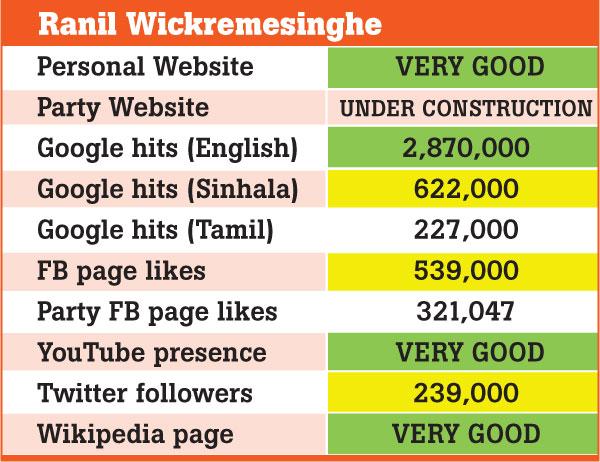
Rohan Pallewatte:
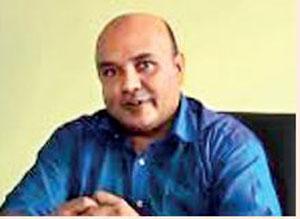
Among the newcomers, Pallewatte does best. At least he has set up a comprehensive website on personal information and party policies. His YouTube presence is not too bad; still no Wikipedia page. Majority of Facebook and Twitter users are yet to learn his existence. Just five months to go. One may be forgiven for wondering whether that is how election propaganda is carried out in Japan where Pallewatte claims to have received his professional training.
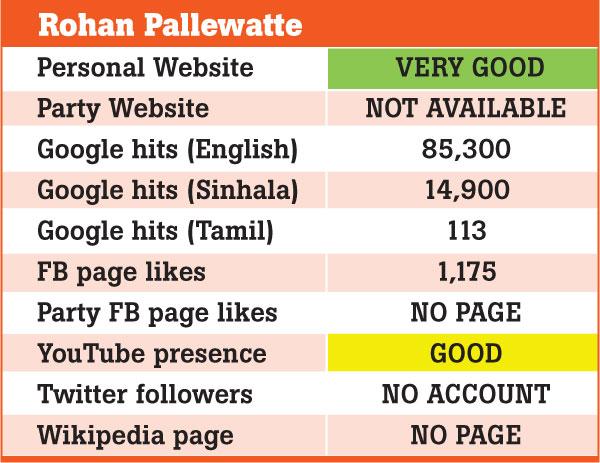
Sajith Premadasa:
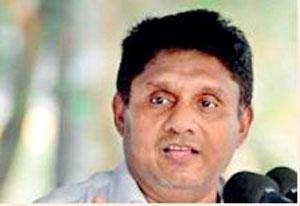
President Ranasinghe Premadasa has been an excellent communicator. In a world that knew neither smartphones nor Internet, he devised innovative solutions to reach the unreachable. Many traditional media channels were disturbed in the wake of 1988 Presidential Election, in which he was the ruling party candidate. Rural television reach was minimal. In some areas rebels have banned all mainstream state media, newspapers, TV and radio. Encountering the challenge positively he launched the famous ‘Me Kavudha? Monavada Karanne?’ islandwide campaign, which took the rivals in surprise. So it is natural the country expects an equally innovative campaign from Sajith Premadasa, exploiting the best of social media capabilities. Perhaps he has a reason to wait for the official announcement. So it may be too early to judge his campaign at this point. Still the right time to start a campaign – a social media campaign – is not the day before nominations.

Conclusion
In an election, every vote counts. They are no more earned purely by traditional loyalties – that era is long gone. It is the stories, as Tyrion Lannister has correctly observed, that unites masses and generate votes. And where do they make stories? In media – print, broadcast and social. The last is the lowest hanging fruit, a natural staring point.
Thus, if one has not attempted it so far, just five months to the race, it could be for two reasons: sheer underestimation of the potential or the thinking that it could be done at the last minute. Both are not good signs. Social media cannot create useful and organic stories overnight. Those who have done it know how long it takes. The stories need not be conclusive. Neither the creation of them requires a formal political party endorsement as a prerequisite. So, by not doing it right now, one is just wasting precious time.
Do social media campaigns cost? Yes, more than one thinks, for multiple reasons. Firstly, it is no more a game of uploading nice photos. Everyone does it – and it adds little value. There should be good content – text, images, audio and video, meaningful, customised, fine-tuned and attractive. Creation of that requires time and effort.
Secondly, differentiation is the name of the game. How to stand higher when everyone else tries the same? Thirdly, negating negative publicity and turning them into positive is a game of its own. These are tasks for professionals. They come with a price tag. Still, that is a price worth paying.
(Chanuka Wattegama, an academic and a public policy researcher with over 10 years’ experience in teaching social media strategies for information systems management students at postgraduate level, can be reached at [email protected])
10 Jan 2025 1 hours ago
10 Jan 2025 1 hours ago
10 Jan 2025 3 hours ago
10 Jan 2025 3 hours ago
10 Jan 2025 3 hours ago